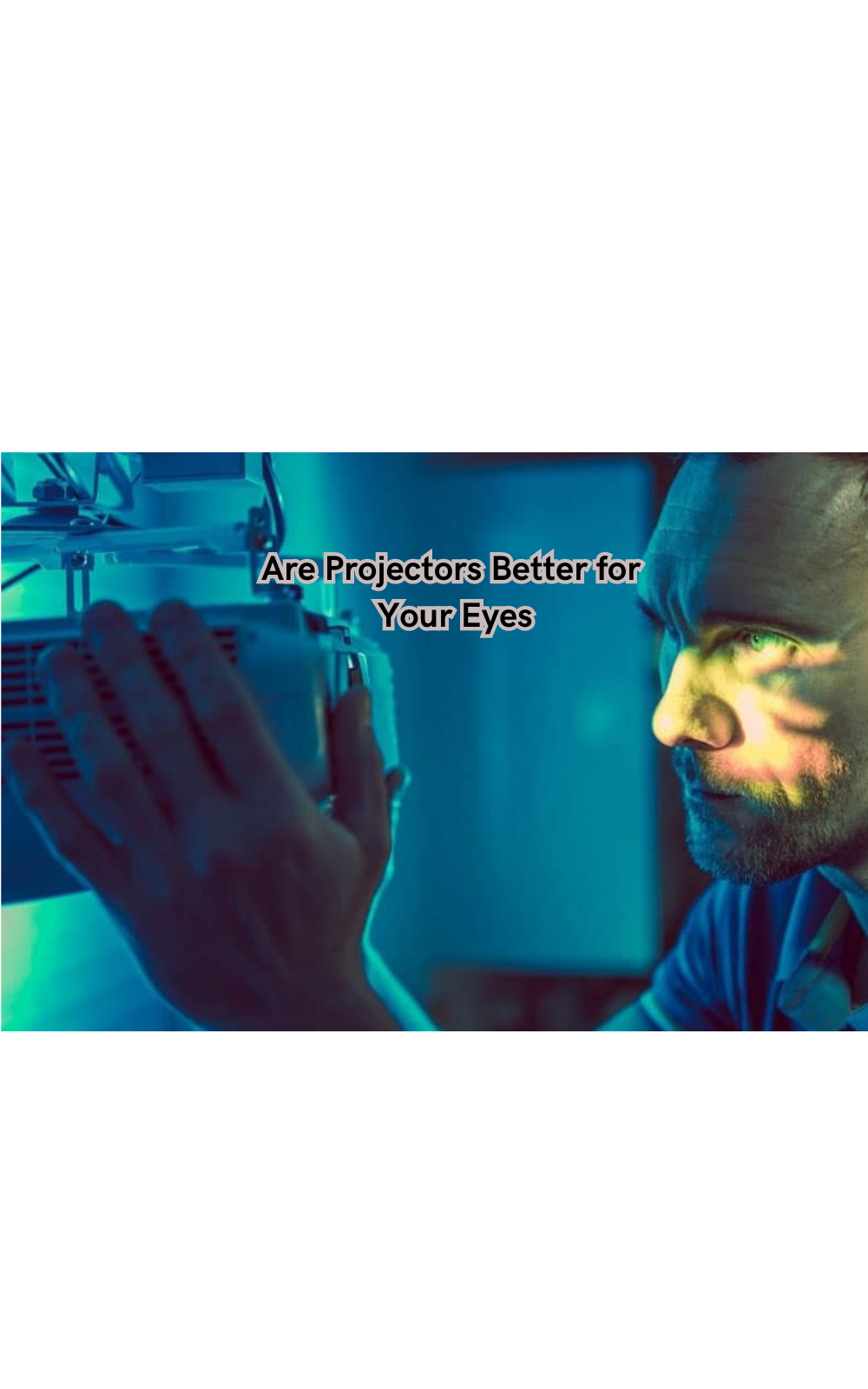Are Projectors Better for Your Eyes

In today's screen-dominated world, many are turning to projectors to watch movies and TV shows, seeking a more eye-friendly viewing experience.
Unlike traditional TV screens, projector screens use reflected light, which is generally gentler on the eyes. Projectors also have the advantage of reducing blue light exposure, a common culprit behind eye strain. However, ambient light can impact the clarity of projector screens, raising questions about their overall effectiveness.
This blog post will explore whether projectors are truly better for your eyes than TV screens, exploring the nuances of light emission and the benefits of each technology.
Understand the Direct or Indirect Light Sources to Eye Health
Light is essential in our visual perception and plays a crucial role in eye health. When it comes to screens, such as computer screens or TV screen options, the type of light source used can significantly impact our eyes.
For instance, direct light emitted from traditional TV screens can be harsh on the eyes due to its intensity and blue light emission. On the other hand, projectors use indirect light reflected onto a projection screen, which can be gentler on the eyes and reduce blue light exposure.
However, ambient light can affect the overall viewing experience on projector screens by reducing clarity and contrast. This makes it important to consider factors like room lighting when using projectors for extended periods.
Ultimately, both direct and indirect light sources have pros and cons regarding eye health, and it's important to find a balance that works best for you.
Are Projectors Better for Your Eyes
Projectors are becoming increasingly popular as an alternative to traditional TV screens for various reasons, including their potential benefits for eye health.
One of the main arguments in favor of projectors is their use of indirect light and reduced blue light emission compared to direct light emitted from TV screens. Using a projector screen, the projected image is created via light bouncing off the surface rather than directly emitting it into our eyes. This results in a softer and more natural viewing experience that can be easier on the eyes.
However, it's important to note that ambient light can still impact the quality of projected images and potentially strain our eyes. Finding a balance between room lighting and projector settings is crucial to optimize the viewing experience while minimizing potential negative effects on eye health.
Potential Benefits of Using Projectors
Aside from potentially being gentler on the eyes and reducing blue light exposure, projectors also offer other benefits that may make them a more appealing option for some individuals.
For one, projectors allow for much larger screen sizes than traditional TVs, making them ideal for movie nights or watching big sporting events. This means less strain on the eyes as you're not squinting at a smaller screen. Additionally, projectors can easily be moved around and used in different locations, making them a versatile choice for those who like to watch TV or movies in different rooms of their home.
Moreover, projectors have come a long way in terms of technology and now offer high-resolution images with vibrant colors and sharp details. This means a more enjoyable viewing experience for the eyes, as you're able to see all the details and colors in their full glory.
Drawbacks of Using Projectors
While projectors may have their potential benefits, they also come with some drawbacks that should be considered before making the switch from traditional TV screens.
One major drawback is the need for a dark or dimly lit room to achieve optimal image clarity and contrast. This can be inconvenient for those who prefer to watch TV with some ambient lighting in the room. Additionally, projectors require a separate screen or wall surface to project onto, which may not always be available or convenient depending on the space and layout of your home.
Moreover, projectors can be more expensive compared to traditional TVs, especially when considering the cost of additional equipment such as screens and mounting materials. They also tend to require more maintenance and adjustments to achieve the best image quality, which may not be suitable for everyone.
Expert Opinions and Studies
The debate on whether projectors are better for the eyes is ongoing, and opinions vary among experts in the field. Some argue that indirect light sources like projectors can be beneficial for eye health, while others argue that it ultimately depends on the individual's viewing habits and screen settings.
One study published by the Journal of Vision found that low ambient lighting combined with a high-quality projector resulted in less strain on the eyes compared to direct light from TV screens. However, the same study also noted that excessive exposure to any type of screen can still lead to eye fatigue and potential long-term effects.
Another study by The Vision Council found that blue light emitted from electronic devices can contribute to digital eye strain and other health issues. They recommend taking breaks from screens and using blue light filtering devices, which some smart projectors offer.
Practical Tips for Minimizing Eye Strain with Projectors
Whether you decide to use a projector or stick with traditional TV screens, there are some practical tips that can help minimize eye strain and potential negative effects on eye health.
- Take regular breaks from screen time and practice the 20-20-20 rule (look at an object 20 feet away for 20 seconds every 20 minutes).
- Adjust the brightness and color temperature of your projector to reduce blue light emission.
- Use low blue light modes if available.
- Ensure proper room lighting to avoid excessive glare or contrast.
- Invest in a high-quality projector and screen for optimal image quality.
By following these tips, you can help create a more comfortable and healthier viewing experience, whether you choose to use a projector or TV screen.
How Projectors Reduce Your Exposure To Blue Light?
One of the main reasons why projectors may be considered better for eye health is their ability to reduce exposure to blue light. Blue light, also known as high-energy visible (HEV) light, is a type of short-wavelength light that is emitted from electronic devices such as TVs, phones, and laptops. It has been linked to digital eye strain and potential long-term effects on eye health.
Projectors can help reduce blue light exposure in two ways:
- Indirect Light Source: Unlike traditional TV screens, projectors use indirect lighting to create images, which results in less direct blue light emission towards the viewer's eyes.
- Low Blue Light Modes: Some smart projectors offer low blue light modes that filter out high levels of blue light, creating a more eye-friendly viewing experience.
While these features may not completely eliminate blue light exposure, they can help reduce it and potentially alleviate some symptoms of digital eye strain. Emitted light levels and the individual's viewing habits also play a significant role in determining the impact of blue light on eye health.
FAQs
Is it OK to use a projector every day?
It is generally safe to use a projector every day as long as proper screen habits and breaks from screen time are practiced. However, it's essential to invest in a high-quality projector and take some precautions to minimize potential negative effects on eye health.
Can projectors damage your eyes?
Projectors themselves do not directly damage the eyes, but they can contribute to eye fatigue and discomfort if used for extended periods or with improper viewing habits. It's crucial to practice good screen habits and take regular breaks from screens for optimal eye health.
Should I use a blue light filter on my projector?
If you're concerned about blue light exposure, using a blue light filter on your projector may be beneficial. However, it's essential to make sure the filter is of high quality and does not negatively impact image quality.
How many hours are projectors good for?
The lifespan of a projector can vary depending on the model and usage. On average, projectors can last anywhere from 2,000 to 20,000 hours before needing to be replaced. It's important to follow manufacturer recommendations for maintenance and replacement to ensure optimal performance and minimize potential negative effects on eye health.
Conclusion
In conclusion, while projectors offer benefits like reduced blue light exposure and the use of reflected light, they are not without drawbacks, such as issues with ambient light and potential resolution concerns.
Traditional TV screens also have their advantages and disadvantages. The key is to consider your individual needs and preferences when choosing between projectors and TV screens.
Regardless of your choice, adopting practices like optimizing lighting and taking regular breaks can help minimize eye strain. Ultimately, whether projectors are better for your eyes depends on personal circumstances and usage habits, so it's essential to evaluate what works best for you.
